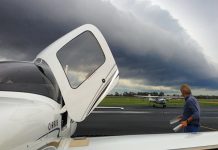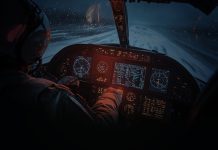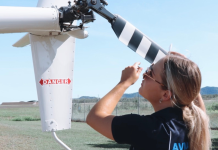See and avoid. Three simple words rolling commandingly off the tongue, right up there with the other great aero-proverbs like ‘aviate, navigate communicate’, ‘speed is life’ and ‘fly safe’.
‘See and avoid’ seems straightforward and simple but also seems, after reading various advisory circulars and research reports, distinctly problematic. In such literature we read advice to scan properly, communicate clearly and maintain situational awareness. It comes with a persistent refrain that because of our optical and cognitive limitations, ‘see and avoid’ won’t help us, well, see and avoid.
So, what are we to do with ‘see and avoid’? Perhaps it’s time for a tweak –one that respects its noble call but, at the same time, better conceptualises its limitations.
Here’s the linguistic tweak. Let’s take the tried (and semi-true) ‘see and avoid’ and add one extra, reality-honouring syllable: ‘fore’. Which give us, ‘foresee and avoid’. This term signposts an anti-collision strategy to mentally enhance ‘look’, ‘scan’, ‘call’ and ‘listen’. It encourages the equally vital call to ‘anticipate’, ‘visualise’, ‘comprehend’ and ‘understand’. It reminds us that vigilance of mind, not just of eye or ear, is demanded.
In my personal ‘overlook and nearly-collide’ shortcomings, albeit thankfully rare, my eyes and ears have not been the main problem (as every medical aircrew will attest). In 30 years at low level, high level, day, night, high-density and low-density airspace and all seasons, weather and terrain, the scary moments have not been merely perceptual but conceptual.
Dark doings
It’s early 1998 and I’m enjoying my dream job. I’m a 20-something Australian Army Aviation troop commander and, with my 20-something copilot, I’m leading a navigation exercise of 2 Hueys. It’s a pretty simple night mission – fly at 200 feet using night vision goggles from Lismore in NSW to Oakey in Queensland through the border ranges, ‘seeing and avoiding’ all the usual suspects, including towers, wires, birds, bats (especially bats) and fellow ground-hugging aviators from RAAF Amberley.
‘See’ means looking through the goggles – 2 small video screens – with no depth perception, no colour and a tight 40° field of view. ‘See’ also means reading and understanding a paper map – achieved by straining both eyes downwards under the goggles and pouting one’s lips to activate the mic-mounted lip light.
Embrace the power of mental practice, also known as mental rehearsal.
No GPS, no moving map display and no smart devices – just old-fashioned map reading assisted by time, heading and our ground speed calculations. And oh, don’t fixate on the map; otherwise, with the windscreen unattended, the towers, wires, birds, bats and any other low-level aircraft may, in the words of aviation legends, ‘rise up and smite thee’. What could go wrong?
Night fright
Surprisingly, everything went mostly right. We wound our way through steep valleys and mountains, seeing and avoiding aforementioned towers, wires, birds, bats and fellow low-level aviators, finally emerging on the western side of the range just east of Warwick. We were out of the mountains and out of the woods but not, as we would soon see (or not see), out of danger.
After the demands of the mountains, my onwards nav plan was fairly simple – a right turn onto 332, fly a few miles to the east of Warwick and then pick up a direct track to Oakey by circumnavigating Clifton at a fly-neighbourly distance. (We know that 2 Hueys at 200 feet above one’s house in the late evening is enough to try even the most patient person!) I pouted my lips to activate the light and peered under the goggles at the wrinkled VTC.

The yellowy-green map marking for Clifton confirmed what I thought I was seeing through the goggles – the green glow of the streetlights of Clifton. Great, an easy nav fix. Let’s just circumnavigate around the town from west to north, pick up our track, and keep going. All good, all normal. Nothing wrong with my eyes. Nothing wrong with the map. Nothing wrong with my perception, but everything wrong with my conception! I wasn’t looking at Clifton – I was looking at Allora, an equally distinctive green glow, about 5 miles closer and perfectly aligned between us and Clifton.
The distinctive ‘wok’ of the Huey deepened as we turned right and then subsided as we levelled out on a heading to take us just north of ‘Clifton’. I looked down at the map again but not to confirm the town of ‘Clifton’ – it was so distinctive, I didn’t feel the need to recheck it – but to check for the next significant tracking feature closer to Oakey and to home.
‘Tower! Breaking right!’
The aircraft snapped right (as much as a Huey can snap) and the woks escalated into angry slaps. I snapped my head up to see the world now at a 60° angle of bank. I saw 2 extremely menacing radio towers looming from ground level to at least 250 feet above us!
Four eyes
I beseech you, in the bowels of Christ, think it possible that you may be mistaken.
– Oliver Cromwell
What happened? It wasn’t just the inherent limitations of ‘see and avoid’. Sure, I needed to check (and recheck) my visual field, but I equally needed to check (and recheck) my mental field. I had not foreseen the way in which my mental world could so confidently reframe Allora into Clifton. I had not foreseen that under a dim light, the map marking of Allora which was obscured by a highway symbol, together with the much larger and more prominent markings of Clifton, made an instinctual (and incorrect) interpretation very likely. Hence, I wasn’t even looking for the towers since the ‘Clifton’ of my mental world had no such towers.
The steep turn deepened as I watched the towers loom large. I instinctively shoved the map down and went to grab the controls but my copilot was all over it. Thankfully, the towers with their ugly array of guy wires disappeared down the left side of the aircraft. My copilot had ‘seen and avoided’ (thanks Luke) but reality remained – we had come way too close to the towers. I had not foreseen and avoided. It was a mental lesson in congestion, confusion and overconfidence I would never forget.
Forethought and avoidance
In my imagination
There is no complication
I dream about you all the time
– Kylie Minogue
Many years later, another dream job and another ‘see and avoid’ challenge, but this time improved by the ‘foresee’ element. It’s 2015, I’m a rescue pilot and we’re lifting vertically out of Toowoomba Base Hospital.
Toowoomba is a contender for the ‘foresee and avoid’ capital of Australia. It’s in a triad of aerodromes (Toowoomba, Wellcamp and Oakey) and is nestled between Amberley’s restricted airspace to the east and Oakey’s to the north-west. And then, for an added challenge, a chunk of Brisbane’s controlled airspace is directly above. All of which means aircraft entering or departing Toowoomba’s circuit area are attending to a whole bunch of ‘seeing and avoiding’. Throw in the ‘rogue molecule’ of a rescue helicopter operating to the hospital, and mental conceptions can get congested and confused very quickly.
It was a mental lesson in congestion, confusion and overconfidence I would never forget.
We were hover climbing vertically through about 200 feet and intending to position for a short transit across to Toowoomba City Aerodrome via runway 29’s base leg. Then we hear an aircraft call, ‘Downwind runway two nine’. Seems innocuous but it’s not. I foresee they are about to turn base which will put them right over the top of the hospital – and right over the top of us.
But I’ve foreseen the downwind pilot overlooking the ‘rogue molecule’ that is our rescue helicopter. I’ve also foreseen they won’t necessarily hear our calls, either because of terrain shielding, their mental framing, their workload or all 3. I changed my plan. Instead of taking the shortcut to the aerodrome (by joining base), we transition to forward flight and take up a south-easterly track away from the hospital. It’s my mentally rehearsed contingency for this situation.
Then we hear, ‘Turning base, runway two nine, Toowoomba’. It’s the aeroplane again. I didn’t catch the callsign but I could tell they haven’t heard my calls. My heart rate quickens. I look back over my right shoulder and sure enough, the silhouette of a light aeroplane is flying into what would have been our flight path. But in this case, unlike Allora, my mental reality satisfyingly correlates to three-dimensional reality. There is no unpleasant near miss. Not even close. Why? It’s the power of ‘foresee and avoid’.
Mental is everything
After Allora and Clifton, I determined to do my best to foresee the preconditions for unreliable judgement – and do something about it. I came across Daniel Kahneman’s research into ‘fast and slow’ thinking (also known as ‘instinctive and deliberate’ thinking). You can Google the depth of this research for yourself but, in essence, when the ‘autopilot’ of the brain – the brain’s mental templates (heuristics) – were instinctively at work, Allora was judged to be Clifton. When the ‘boardroom of the brain’ – the brain’s deeper conceptualisations – are deliberately at work, Toowoomba’s tricky ‘see and avoid’ dynamics are foreseen and near misses or collisions are avoided.
There are many ways to fully leverage Khaneman’s research, but here are 2 of the easiest. First, embrace the power of mental practice, also known as mental rehearsal. This means, in the context of ‘foresee and avoid’, deliberately thinking through, and mentally practising, the various ways ‘see and avoid’ might be subverted by congestion, confusion and overconfidence.
I saw 2 extremely menacing radio towers looming from ground level to at least 250 feet above us!
I’d mentally rehearsed the Toowoomba hospital situation. I’d foreseen that a westerly wind put the base turn point roughly over the top of the hospital and an aeroplane in the circuit would probably not hear my calls. So, when it did happen, I’d mentally rehearsed what I’d do. As one of my first instructors used to say, ‘We should never go anywhere we haven’t already gone in our minds.’
Second, fight for a pause, that is, fight for time and space. This might be, if safely appropriate, holding or going around or climbing or anything else that encourages the activation of deliberate thinking. Consider also providing other aircraft with similar pauses in space and time. When we do this, we protect our cognitive bandwidth and the bandwidth of others.
There’s much more that can be said about ‘foresee and avoid’ but to summarise, we do well to respect the limitations of the Mark 1 eyeball. We do even better to respect the dynamics of our mental world. It’s here we curate, cohere and correlate what we see. It’s here we decide to act, or not to act. When you next fly, I hope you see things, and foresee things, the same way.






Comments are closed.